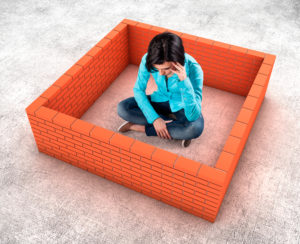 More Cognitive Distortions
More Cognitive Distortions
My last article, Common Thinking Traps summarized the thinking traps of Labelling, Fortune Telling, Mind-Reading, Filtering, and Black and White Thinking. Today I will cover the other four which I teach in my groups and to individuals. These thinking traps are discussed in detail on the excellent website www.anxietybc.com.
Over-generalization
This is when we have a fixed mind-set and use words such as “always” or “never” to describe our situation. We have no proof that situations or events are going to “always” be a certain way or “never” go in our favour, but this kind of thinking feeds into negative irrational thinking. Sometimes things don’t work out the way we hoped but this doesn’t mean that it’s going to always be this way or never work out. Our brains continue to grow forever, and although we may have different strengths and weaknesses, we can always focus on strengthening our weaknesses.
Eg. I will never be good at math.
I always mess up when I do oral presentations.
Over-estimating danger
This is when we believe that something scary or dangerous is about to happen. Many children and teens develop a fear of vomiting, after being sick and vomiting. Others worry that the moment they step outside, there will be an earthquake. After stepping in a wasps’ nest today (the second one in a month!) my son and I are currently feeling hyper-alert for wasps and over-estimating danger as soon as we step outside.
Catastrophizing
This is when we think that the worst possible event or situation is about to happen, and we assume that we won’t be able to manage. However the evidence (the statistic) prove that these situations are infrequent and we will be able to survive.
Should statements
When we place “shoulds” on ourselves or others, we set ourselves or others up for failure. We can wish for things, but we can’t make demands that things must, should or ought to go a certain way. We would like to be treated with respect but we can’t make this demand on others, as ultimately we can’t control others. If you tell yourself that you should feel happy, you can make yourself feel worse with this demand on your emotions.
Some people’s temperament is to be more pessimistic, and sometimes this can also be more realistic. However, it can also drain one’s energy as one focuses on everything that could go wrong. For people with higher anxiety, it is as if they have an over-active smoke alarm, with the Amygdala (the emotional, instinctual centre and fight/flight/freeze center) being the over-active alarm that is constantly on alert for danger. The positive side of the coin is that these people also tend to be very sensitive and often creative. They seem to be very aware and absorb much more from their environment. It is therefore, very important to focus on being Mindful (in the present moment without judgment), and practice breathing exercises to strengthen the calming pre-frontal cortex region of the brain. For audio recordings of calm breathing exercises, and visualizations, download the free app Mindshift which I wrote about a few weeks ago.
We all have anxiety and we need it to protect us. It becomes a problem when it starts to affect our daily functioning or starts to pop up more frequently and in more situations. Fortunately, there are excellent, evidence-based strategies which help us all to handle stress and anxiety. (My groups are catered to all children – to help the ones experiencing higher anxiety and to teach pro-active life-skills to children with average amounts of anxiety.)
Try to catch your negative, irrational thoughts and identify which “Thinking Trap” they represent. Some thoughts fit into more than one category. Dr. David Burns, the author of Feeling Good, says one of the best strategies for managing anxiety is to divide a page into three columns and write the negative thought in the first column, the name(s) of the thinking trap(s) (cognitive distortions) in the second column and to write a more rational and positive thought in the last column.
Warmly,
Want to Connect?
Subscribe now to receive free weekly parenting tips and inspiration.







